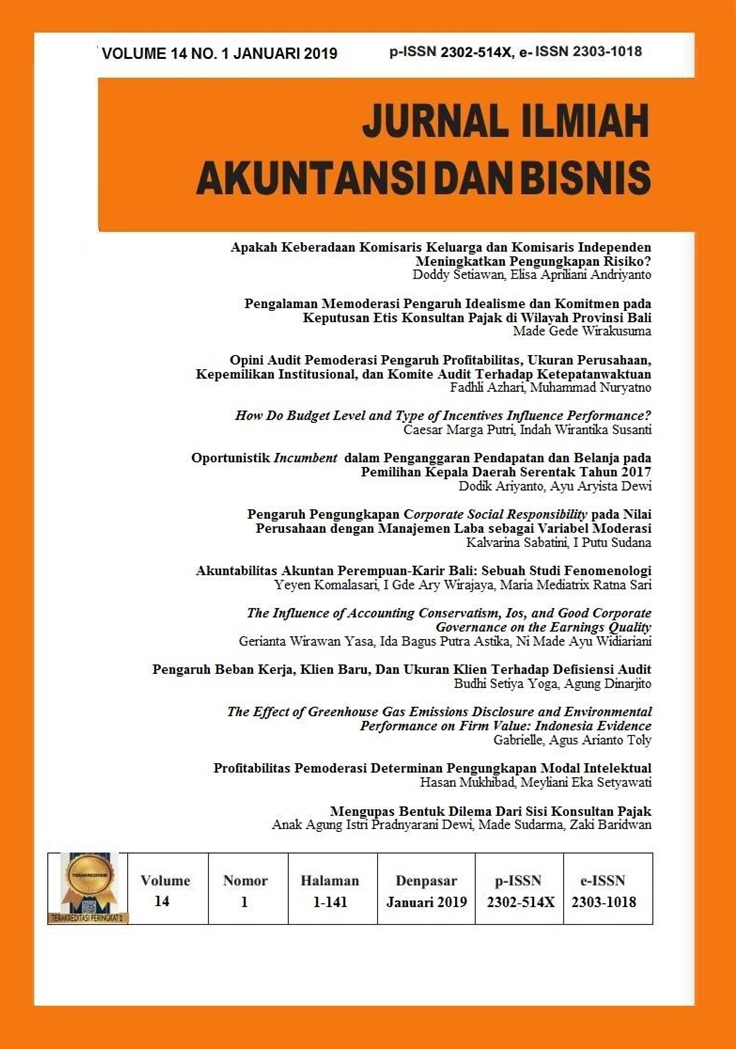Mengupas Bentuk Dilema Dari Sisi Konsultan Pajak
Abstract
This study aims to explore how the natural shape of the dilemmas in tax consulting and how the experience of overcoming dilemmas, is felt especially when doing tax planning. The qualitative method has been used with the interpretive paradigm according to the approach of transcendental phenomenology of Husserl. The informant in this study is a tax consultant of IKPI Denpasar. The research results reveal that dilemma forms tax consultants such that the dilemma posed by tax consultants have concern for the client and tax consultants think of business continuity services. The dilemma forms generate tax consulting experience in overcoming the perceived dilemma that is by building awareness of the taxpayer and must be aware of the profession as a tax consultant who is bound by the code of conduct. The dilemma can be overcome by building awareness of taxpayers and having strong principles to comply with the code of ethics.
Keywords: Ethical Dilemma, Tax Consultants, Tax Planning, Taxpayer Compliance, Phenomenology
Downloads
References
Erard, B. (1993). Taxation with Representation: An Analysis of The Role of Tax Practitioners in Tax Compliance. Journal of Public Economics, 52(2), 163–197.
Fitriani, E. I. (2014). Makna Harga Diri Pada Remaja Putri Yang Melakukan Hubungan Seksual Pranikah Di Pekanbaru. Universitas Islam Negeri Sultan Sarif Kasim Riau.
Frecknall-Hughes, J., & Krichler, E. (2015). Towards a General Theory of Tax Practice. Social & Legal Studies, 24(2), 289–312.
Katuuk, D., Manossoh, H., & Walandouw, S. K. (2017). Pengaruh Integritas Dan Kreativitas Konsultan Pajak Terhadap Kepatuhan Wajib Pajak. Jurnal Riset Akuntansi Going Concern, 12(2), 1–8.
Kuswarno, E. (2009). Meotde penelitian komunikasi fenomenologi. Bandung: Widyapadjajaran.
Mangoting, Y. (2017). Menguak Dimensi Kecurangan Pajak. Jurnal Akuntansi Multiparadigma (JAMAL), 8 (2), 227–429.
Massie, J. M. (2017). Pengaruh Etika Profesi, Religiusitas dan Kompetensi Terhadap Pengambilan Keputusan Etis Konsultan Pajak. Universitas Kristen Maranatha.
Maulidya, D. (2016). Dilema Etik Sebagai Konsultan Pajak. Retrieved from http://debbymaulidya.blogspot.com/2016/12/dilema-etik-sebagai-konsultan-pajak.html
Noviriani, E. (2015). Studi Fenomenologi Atas Dilema Etis Auditor Internal Pemerintah. Ekuitas: Jurnal Ekonomi Dan Keuangan, ISSN 1411.
Putu, W. P. (2009). Konstruksi Gender. Universitas Indonesia.
Sanders, P. (1982). Phenomenology?: A New Way of Viewing Organizational Research. The Academy of Management Review, 7(3), 353–360.
Suardika. (2016). Desain Pembelajaran Dengan Pendekatan Siklus Belajar (learning Cycle). Retrieved from https://aritmaxx.wordpress.com/2016/10/17/desain-pembelajaran-dengan-pendekatan-siklus-belajar-learning-cycle/
Suryowati, E. (2016). Apa Perbedaan Praktik Penghindaran Pajak dan Penggelapan Pajak? Retrieved from https://bisniskeuangan.kompas.com/read/2016/04/14/083000826/Apa. Perbedaan.Praktik.Penghindaran.Pajak.dan.Penggelapan.Pajak.
Windesi, E. M. (2016). Pengaruh Faktor Individu: Persepsi Pentingnya Etika Dan Tanggung Jawab Sosial, Machiavellianism, Dan Locus of Control Terhadap Pengambilan Keputusan Etis Akuntan Pajak Dalam Perencanaan Pajak (Tax planning). Universitas Brawijaya.




















